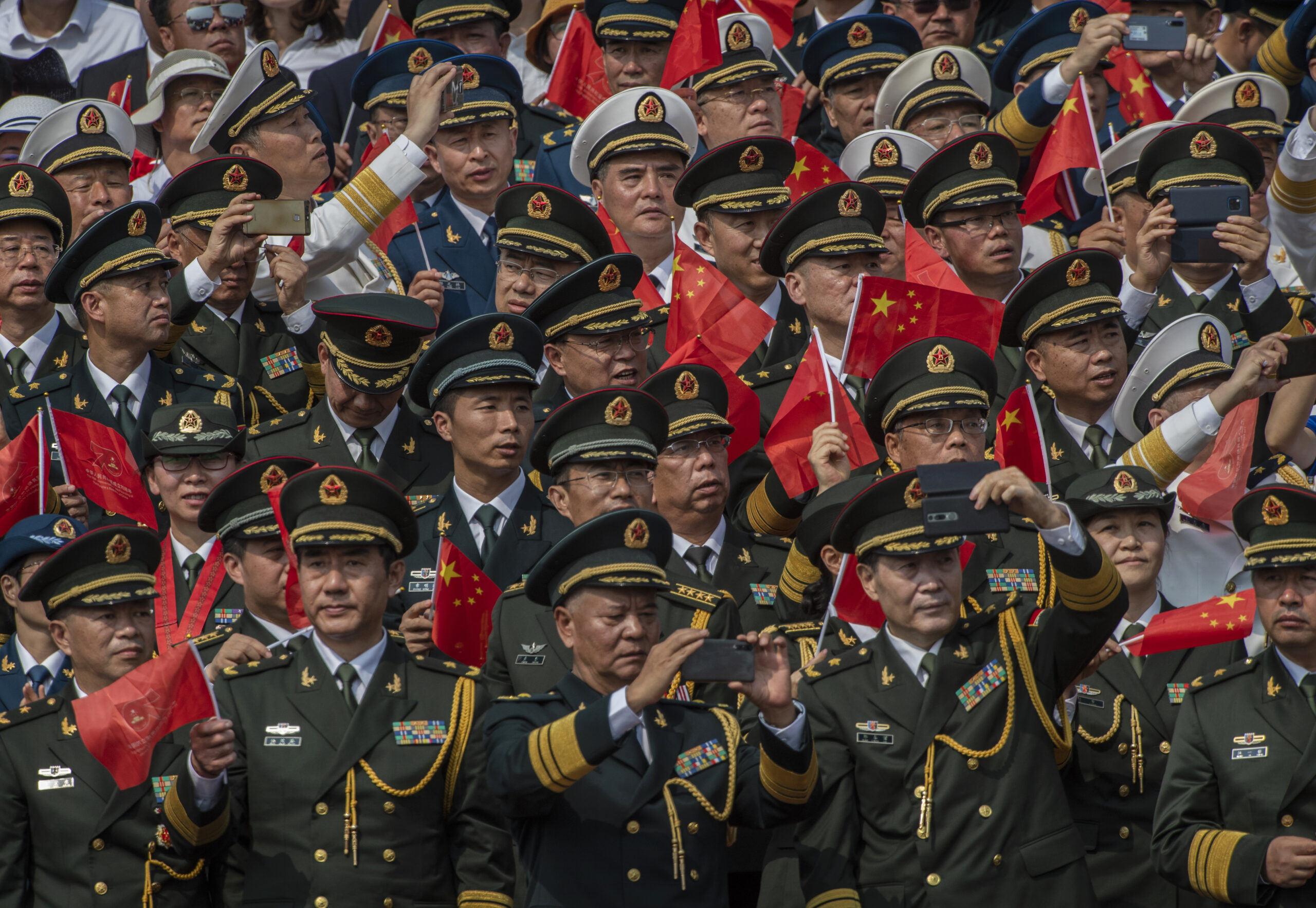
Chinese military officers celebrate the 70th Anniversary of the founding of the People’s Republic of China (Kevin Frayer/Getty Images)
WASHINGTON: The now-infamous phone calls between the heads of America’s and China’s militaries earlier this year to avert conflict resulting from bad Chinese intelligence about a US plan to attack highlights the risks of strategic miscalculation by both countries.
Almost exactly a year since the first phone call between Chairman of the Joint Chiefs of Staff Gen. Mark Milley and his Chinese counterpart, the biggest takeaway from the Pentagon’s new report on China’s growing military might be the danger of exactly the kind of miscalculation Milley sought to avoid.
“As the PLA develops and expands its reach globally, the risk of an accident or miscalculation also increases, putting a premium on risk reduction efforts and highlighting the need to ensure the safety of U.S. forces operating in close proximity,” the report says. “This evolving condition has further emphasized the importance of establishing timely communications during a crisis, and to maintaining regular communication channels to prevent crisis and conduct post crisis assessments.”
Two controversial calls, perhaps a disaster averted
The exchange of calls between Milley and Gen. Li Zuocheng were meant to assure the Chinese that the United States did not plan to attack. News of the calls were first aired in excerpts from the book “Peril,” by Washington Post journalists Bob Woodward and Robert Costa.
In a memo written for a Senate Armed Services Committee hearing, Milley detailed Pentagon policy for contacting senior Chinese military officials. Known as “Guidance for U.S. Department of Defense Contacts and Exchanges with the Peoples Republic of China (PRC),” the 2019 and 2020 versions under President Trump “directed the DoD to routinize and prioritize DoD contacts and exchanges with the PLA to enhance predictability, stability, and prevent an íncident between U.S. and PRC operational forces from inadvertently escalating to crisis [emphasis added].”
The calls between Milley and Li, among other communications, actually did achieve those goals, the new Pentagon report concludes:
“On October 29, 2020, a PRC Ministry of National Defense spokesman stated that then-U.S. Secretary of Defense Mark Esper had ‘specifically clarified… through military and diplomatic channels’ that the relevant reports ‘did not match facts’ and that the United States ‘had no intention of instigating a military crisis against China.’ These events highlighted the potential for misunderstanding and miscalculation, and underscored the importance of effective and timely communication between DoD and the PLA.”
Beijing expands nuclear capabilities, might already have ‘nuclear triad’
Such miscalculations could grow increasingly dangerous as China expands its nuclear forces, as the report estimates it is.
“Last year, DoD estimated that the PRC had a nuclear warhead stockpile in the low-200s and projected it to at least double over the next decade. Since then, Beijing has accelerated its nuclear expansion, which may enable the PRC to have up to 700 deliverable nuclear warheads by 2027 and likely intends to have at least 1,000 warheads by 2030 [emphasis added],” the report says. “The PRC is constructing the infrastructure necessary to support this force expansion, including increasing its capacity to produce and separate plutonium by constructing fast breeder reactors and reprocessing facilities.
On top of that, China “is building hundreds of new ICBM silos, and is on the cusp of a large silo-based ICBM force expansion comparable to those undertaken by other major powers,” the report says. Some of those silos appear ready to be used for smaller solid-fueled ICBMs.
More broadly, China appears eager to join the tiny group of states that possess a nuclear triad.
“The PRC has possibly already established a nascent ‘nuclear triad’ with the development of a nuclear capable air-launched ballistic missile (ALBM) and improvement of its ground and sea-based nuclear capabilities,” the report says. It also notes that in October 2019 “the PRC signaled the return of the airborne leg of its nuclear triad after the PLAAF publicly revealed the H-6N as its first nuclear-capable air-to-air refuelable bomber.”
The report points to “a lack of transparency by China” in terms of reporting on its nuclear testing “which has included frequently blocking the flow of data from its International Monitoring System (IMS) stations” to the Comprehensive Nuclear Test-Ban Treaty Organization. This, the report avers, raises “concerns regarding its adherence to the ‘zero yield’ standard adhered to by the United States, United Kingdom, and France in their respective nuclear weapons testing moratoria.”
More broadly, Gen. Mark Milley, chairman of the Joint Chiefs of Staff, offered some perspective on China’s rise to power in an interview Wednesday.
“If you look at, again, 40 years ago, they had zero satellites. Look at what they’ve got today. They had no ICBMs. Look at what they’ve got today. They had no nuclear weapons. Look at what they’ve got today. They had no fourth or fifth generation fighters or even more advanced fighters, back then. Look at what they’ve got today. They had no navy. Look what they have today. They had no sub force. Look at what they have today,” he said, answering a question about the recent test of a Fractional Orbital Bombardment System (FOBS) with a hypersonic weapon.
While Milley would not go into any detail about the test, citing classification, he made clear that it only one significant part of a remarkable vault to the upper tiers of military power by China.
“So if you look at the totality, this test that occurred a couple weeks ago, is only one of a much, much broader picture of a military capability with respect to the Chinese. That is very, very significant,” he said. “We’re witnessing, in my view, we’re witnessing one of the largest shifts in global geostrategic power that the world has witnessed.”






















